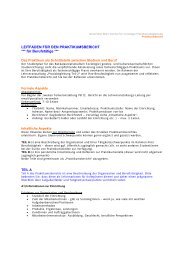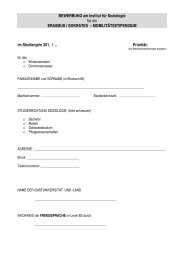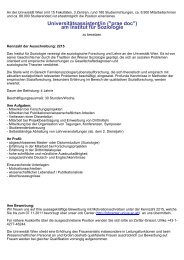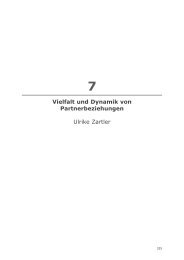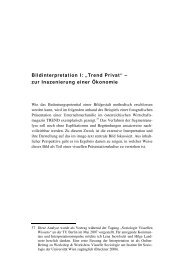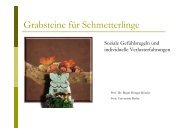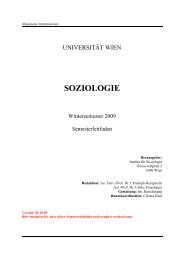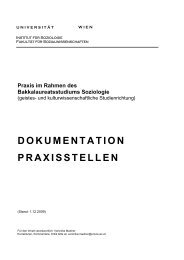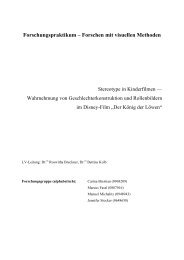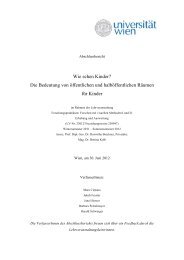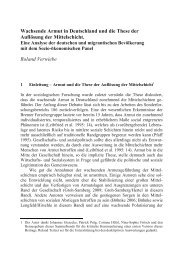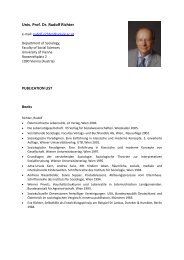Why do Europeans Migrate to Berlin? SocialStructural Differences ...
Why do Europeans Migrate to Berlin? SocialStructural Differences ...
Why do Europeans Migrate to Berlin? SocialStructural Differences ...
Create successful ePaper yourself
Turn your PDF publications into a flip-book with our unique Google optimized e-Paper software.
10 Verwiebe<br />
was studied against the background of the European integration process.<br />
Funded by a research grant from the German Research Foundation, the<br />
BSTME-project was carried out in <strong>Berlin</strong> using a qualitative study and a<br />
quantitative survey. 6<br />
Data<br />
For the quantitative analysis, a data set of 1,040 European citizens<br />
[from Italy (n = 210), France (n = 302), Great Britain (n = 270), and<br />
Poland (n = 258)] was used. This data set is based on a standardised,<br />
postal survey of 2,043 European nationals plus a German control group,<br />
who were ran<strong>do</strong>mly selected from the records of the <strong>Berlin</strong> state census<br />
bureau and who were representative with regard <strong>to</strong> age and gender for<br />
the examined groups. Nine out of ten of those interviewed moved <strong>to</strong><br />
<strong>Berlin</strong> directly from another European country, a smaller portion had<br />
spent some time in another German city before coming <strong>to</strong> <strong>Berlin</strong>. From<br />
this survey (n = 2,043), migrants were selected who moved <strong>to</strong> <strong>Berlin</strong><br />
between January 1980 and January 2002 (n = 1,040). Additionally, they<br />
had <strong>to</strong> be registered at the State Census Bureau, which is obliga<strong>to</strong>ry for<br />
all individuals in Germany. Due <strong>to</strong> the fact that a ran<strong>do</strong>mly-selected,<br />
representative sample from the records of the <strong>Berlin</strong> state census uses<br />
only registered EU-migrants, neither return migrants nor illegal migrants<br />
are contained in the sample. Both phenomena are, however, quite extensively<br />
examined in the research. 7<br />
The BSTME-project used clear and well-established metho<strong>do</strong>logical<br />
principles in order <strong>to</strong> guarantee high-quality data. To that end,<br />
Dillman’s Total Design Method (2002) was used for the mail survey, the<br />
questions in the questionnaire were <strong>to</strong> a large extent based on tested<br />
scales available from the ZUMA-Handbook of Scales (see http://<br />
www.gesis.org/en/services/methods/services/zisehes/), a questionnaire in<br />
German and in the native language of the respondents was sent out, the<br />
questionnaires were translated by professional transla<strong>to</strong>rs, and the main<br />
survey was preceded by a pre-test using approximately 4 per cent of the<br />
<strong>to</strong>tal 2,043 cases studied in the main survey. The main survey was carried<br />
out within a relatively short period, between January and March of<br />
2002, with a return rate of approximately 20 per cent.<br />
This response rate needed <strong>to</strong> be examined with regard <strong>to</strong> the data quality.<br />
A first look at the literature showed that the response lies within the<br />
usual spectrum of response rates (between 5 and 50%) in the research<br />
(Dillman, 2000). 8 In a second step, the demographic composition of the<br />
Ó 2011 The Author<br />
International Migration Ó 2011 IOM





